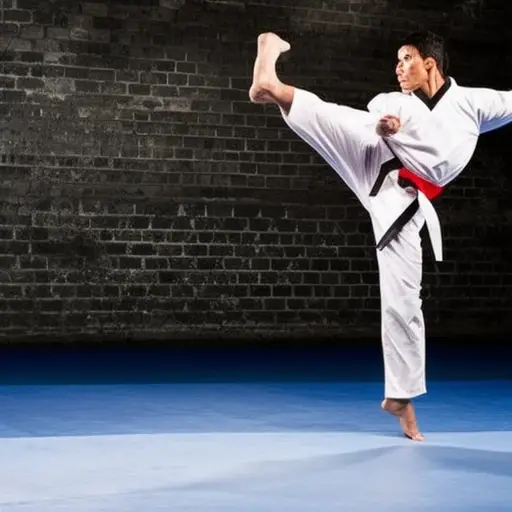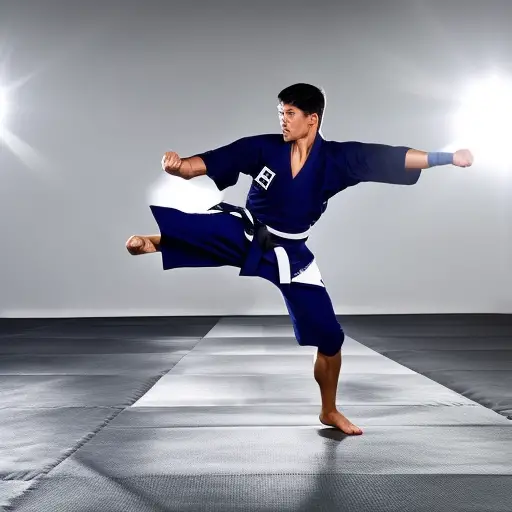Building Endurance for Long Taekwondo Sessions

In the electrifying realm of taekwondo, the ability to endure is as vital as a steady heartbeat. Just as a crescendo builds upon itself, so too must practitioners cultivate their endurance to withstand the rigorous demands of long training sessions.
This article unravels the significance of endurance in taekwondo, providing practical insights and effective strategies to fortify one’s stamina.
By combining cardiovascular exercises, strength training, and proper recovery techniques, individuals can unlock the boundless potential within, achieving lasting endurance for triumphant taekwondo sessions.
Understanding the Importance of Endurance in Taekwondo
In the realm of Taekwondo, it is imperative to comprehend the significance of endurance for the purpose of excelling in the rigorous physical demands and prolonged training sessions. Endurance training benefits practitioners by improving their cardiovascular fitness, muscular strength, and mental stamina. By enhancing these aspects, athletes are able to perform at their best for extended periods of time.
To improve endurance in Taekwondo, several strategies can be implemented. Firstly, incorporating aerobic exercises such as running, swimming, or cycling into training routines can enhance cardiovascular endurance. These activities help to strengthen the heart and lungs, enabling practitioners to sustain physical exertion for longer durations.
Additionally, interval training can be effective in building endurance. This involves alternating periods of intense activity with periods of rest or lower intensity. This method challenges the body and helps to improve stamina and recovery time.
Furthermore, practicing high-intensity drills and sparring sessions can simulate the demands of actual competition, pushing athletes to their limits and improving their endurance. It is also important to incorporate strength training exercises to build muscular endurance, as strong muscles are better equipped to endure the physical demands of Taekwondo.
Setting Realistic Goals for Endurance Training
Establishing attainable objectives is crucial when it comes to endurance training, as it allows Taekwondo practitioners to effectively track their progress and stay motivated throughout their training journey. Setting realistic goals not only helps in monitoring one’s development but also provides a sense of accomplishment when milestones are achieved.
To aid in goal-setting, a table can be used to outline specific targets for endurance training. The table below provides an example:
| Goal | Target | Timeline |
|---|---|---|
| Increase running distance | Run an additional 0.5 miles per week | Achieve in 2 months |
| Improve kicking stamina | Perform 50 consecutive kicks without rest | Achieve in 1 month |
| Enhance sparring endurance | Last 3 rounds of sparring without exhaustion | Achieve in 3 months |
By setting clear objectives with specific targets and timelines, Taekwondo practitioners can easily track their progress and have a sense of direction in their training. It is important to regularly assess and adjust these goals to ensure continuous improvement and avoid stagnation.
Tracking progress is essential for endurance training as it allows individuals to see how far they have come and motivates them to keep pushing forward. However, it is common to encounter plateaus during training, where progress seems to stall. During such times, it is important to reassess goals, make necessary adjustments to training routines, and seek guidance from coaches or trainers to overcome these plateaus and continue progressing towards improved endurance.
Effective Cardiovascular Exercises for Building Endurance
Cardiovascular exercises such as running, cycling, and swimming are effective for building endurance in Taekwondo practitioners. Incorporating these exercises into your training routine can help improve your cardiovascular fitness and increase your stamina during long Taekwondo sessions.
Here are four effective cardiovascular exercises that can enhance your endurance:
-
Running: Running is a versatile exercise that can be done outdoors or on a treadmill. It not only strengthens your cardiovascular system but also works your leg muscles, improving your overall fitness.
-
Cycling: Cycling is a low-impact exercise that puts less stress on your joints while still providing a great cardiovascular workout. It can be done outdoors or on a stationary bike, allowing you to adjust the intensity according to your fitness level.
-
Swimming: Swimming is a full-body workout that engages multiple muscle groups while providing a low-impact cardiovascular exercise. It is an excellent option for those with joint issues or injuries.
-
High Intensity Interval Training (HIIT): HIIT involves alternating between intense bursts of exercise and short recovery periods. This type of training has been shown to improve endurance and maximize calorie burn in a short amount of time.
Incorporating cross-training strategies such as these cardiovascular exercises can help you build endurance and enhance your performance in Taekwondo. However, to further enhance your endurance, it is important to also incorporate strength training into your training routine.
Incorporating Strength Training for Endurance Enhancement
To optimize endurance enhancement in Taekwondo, it is essential to incorporate strength training alongside cardiovascular exercises. While cardiovascular exercises help improve cardiovascular fitness and stamina, strength training techniques specifically target muscular endurance, allowing athletes to perform at a high level for extended periods.
When incorporating strength training into your endurance training regimen, it is important to focus on exercises that target the major muscle groups used in Taekwondo, such as the legs, core, and upper body. Squats, lunges, push-ups, and planks are all effective exercises that can improve muscular endurance. Performing these exercises with lighter weights and higher repetitions will help build endurance without adding excessive bulk.
In addition to strength training, proper nutrition is crucial for endurance enhancement. Consuming a balanced diet that includes lean proteins, whole grains, fruits, and vegetables will provide the necessary nutrients for muscle repair and growth. It is also important to stay hydrated and fuel your body with carbohydrates before and after training sessions to maintain energy levels.
Incorporating strength training techniques and following a nutritious diet will help athletes in Taekwondo develop the endurance necessary to perform at their best during long training sessions and competitions.
Implementing Proper Recovery Methods for Sustained Endurance
Implementing effective recovery methods is crucial for athletes to sustain their endurance and optimize performance in Taekwondo. Proper recovery allows the body to repair, rebuild, and adapt to the physical demands of training, ensuring that athletes can consistently perform at their best. Here are four key strategies for implementing proper recovery methods:
-
Nutrition strategies for optimal recovery: Consuming a balanced diet with adequate protein, carbohydrates, and healthy fats is essential for replenishing energy stores and supporting muscle recovery. Including foods rich in antioxidants, such as fruits and vegetables, can also help reduce inflammation and promote faster recovery.
-
Importance of rest and sleep in endurance building: Rest days are important for allowing the body to recover and adapt to training. Adequate sleep is also crucial for optimal recovery, as it promotes hormone balance, muscle repair, and mental rejuvenation. Aim for 7-9 hours of quality sleep each night.
-
Active recovery exercises: Engaging in low-intensity activities, such as swimming or light jogging, can help increase blood flow to the muscles and facilitate the removal of metabolic waste products. Active recovery exercises can also help reduce muscle soreness and improve overall recovery.
-
Proper hydration: Staying adequately hydrated is essential for optimal recovery. Water helps transport nutrients to the muscles and aids in the removal of waste products. During intense training sessions, it is important to drink enough fluids to replace the water lost through sweat.
Frequently Asked Questions
What Are Some Common Mistakes to Avoid While Training for Endurance in Taekwondo?
Common mistakes in endurance training for taekwondo include overtraining without proper rest, neglecting strength training, and failing to establish a consistent training routine. Effective strategies for improving endurance include interval training, cross-training, and gradual progression in intensity and duration.
How Can I Prevent Injuries While Working on Building Endurance?
To prevent injuries while working on building endurance in Taekwondo, it is important to implement injury prevention techniques. These may include proper warm-up and cool-down routines, using appropriate protective gear, maintaining proper form and technique, and gradually increasing intensity and duration of training sessions.
Are There Any Specific Dietary Recommendations for Optimizing Endurance in Taekwondo?
Proper nutrition plays a vital role in optimizing endurance for Taekwondo. Adequate intake of carbohydrates, proteins, and fats, coupled with regular hydration, can enhance performance and sustain energy levels during long training sessions.
Can I Build Endurance Through Other Martial Arts or Sports Activities?
Cross training in other martial arts or sports activities can help build endurance for long Taekwondo sessions. However, it is important to incorporate rest days to allow the body to recover and prevent overtraining.
How Long Does It Usually Take to See Improvements in Endurance With Consistent Training?
Improvements in endurance timeline vary depending on individual factors, such as fitness level and training consistency. However, with consistent training and proper techniques, noticeable improvements can be seen within a few weeks to a few months. Effective endurance training involves gradually increasing intensity, incorporating interval training, and maintaining a balanced diet and rest.
Conclusion
In conclusion, building endurance is essential for long taekwondo sessions. Setting realistic goals, incorporating effective cardiovascular exercises, and implementing strength training are key strategies for enhancing endurance.
Additionally, proper recovery methods are crucial for sustained endurance. By consistently following these practices, taekwondo practitioners can improve their stamina and performance in the sport.
As the saying goes, "Endurance is the fuel that keeps the taekwondo fire burning." By building up their endurance, taekwondo practitioners can push past their limits and achieve greatness in the martial art.





